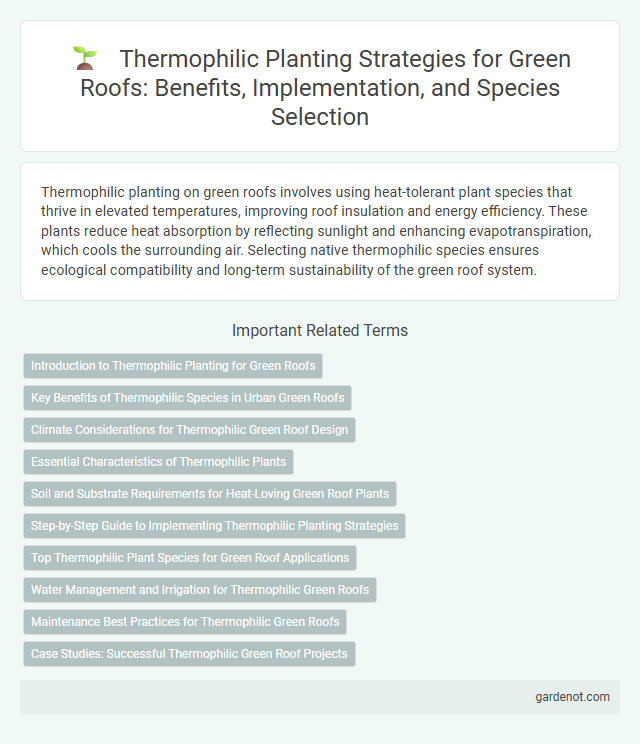Thermophilic planting on green roofs involves using heat-tolerant plant species that thrive in elevated temperatures, improving roof insulation and energy efficiency. These plants reduce heat absorption by reflecting sunlight and enhancing evapotranspiration, which cools the surrounding air. Selecting native thermophilic species ensures ecological compatibility and long-term sustainability of the green roof system.
Introduction to Thermophilic Planting for Green Roofs
Thermophilic planting on green roofs involves selecting heat-tolerant plant species capable of thriving in high-temperature environments typical of rooftop surfaces. These plants, such as Sedum and other drought-resistant succulents, help reduce urban heat island effects by providing insulation and promoting evapotranspiration. Incorporating thermophilic species enhances green roof durability, water conservation, and energy efficiency in building design.
Key Benefits of Thermophilic Species in Urban Green Roofs
Thermophilic species on urban green roofs enhance heat tolerance and improve thermal regulation by withstanding high temperatures, reducing roof surface heat absorbance. Their deep root systems promote efficient water retention and drought resistance, mitigating urban heat island effects and lowering building energy consumption. These plants also support biodiversity by providing unique habitats for heat-adapted pollinators and insects in challenging urban environments.
Climate Considerations for Thermophilic Green Roof Design
Thermophilic planting on green roofs thrives best in regions with high ambient temperatures and extended periods of intense sunlight, leveraging heat-tolerant species like Sedum and native succulents to optimize thermal regulation. Climate considerations for thermophilic green roof design include selecting drought-resistant plants that reduce irrigation requirements and enhance urban heat island mitigation during heat waves. Proper substrate composition and depth must support these species' root systems while facilitating effective water retention and drainage under extreme weather conditions.
Essential Characteristics of Thermophilic Plants
Thermophilic plants thrive in high-temperature environments, exhibiting heat tolerance and drought resistance essential for green roof sustainability. Their deep root systems and efficient water-use mechanisms enable survival under intense solar radiation and limited moisture availability. These plants contribute to improved thermal regulation on green roofs by enhancing insulation and reducing heat island effects.
Soil and Substrate Requirements for Heat-Loving Green Roof Plants
Thermophilic plants on green roofs require well-draining, nutrient-rich substrates with high thermal mass to retain heat and support microbial activity essential for growth. The soil mix should include components like expanded clay, pumice, or volcanic rock to enhance aeration and moisture retention while preventing waterlogging. Optimal substrate depth ranges from 10 to 20 cm, balancing root development and temperature regulation for heat-loving vegetation.
Step-by-Step Guide to Implementing Thermophilic Planting Strategies
Thermophilic planting on green roofs enhances heat tolerance by selecting thermophilic species such as Sedum and Delosperma, which thrive in high-temperature environments. Begin by analyzing local climate data to identify peak heat periods and soil conditions, then prepare a well-draining, nutrient-rich substrate optimized for thermal retention. Implement planting in phases, ensuring proper irrigation techniques and monitoring plant health through thermal imaging to adjust strategies for maximum resilience and energy efficiency.
Top Thermophilic Plant Species for Green Roof Applications
Thermophilic plant species such as Sedum acre, Delosperma cooperi, and Sempervivum tectorum are ideal for green roof applications due to their exceptional heat tolerance and drought resistance. These plants thrive in high-temperature environments, ensuring long-term vegetation cover and reducing cooling loads in urban buildings. Incorporating top thermophilic species enhances biodiversity and sustainability while minimizing maintenance requirements on green rooftops.
Water Management and Irrigation for Thermophilic Green Roofs
Thermophilic planting on green roofs requires efficient water management strategies to maintain plant health under high-temperature conditions, using drought-tolerant species that reduce irrigation frequency. Incorporating advanced irrigation systems such as drip or sensor-based irrigation optimizes water usage by targeting root zones and minimizing evaporation losses. Soil amendments with water-retentive materials like hydrogels enhance moisture retention, supporting thermophilic vegetation during extended dry periods.
Maintenance Best Practices for Thermophilic Green Roofs
Thermophilic green roofs require regular monitoring of soil temperature and moisture levels to ensure optimal plant health and thermal regulation. Implementing a tailored irrigation schedule and removing accumulated debris prevents heat stress and promotes vigorous growth of thermophilic species like Sedum and Delosperma. Seasonal inspections allow for timely pruning and replacement of underperforming plants, sustaining the roof's insulation efficiency and biodiversity.
Case Studies: Successful Thermophilic Green Roof Projects
Thermophilic planting on green roofs thrives in high-temperature conditions, enhancing urban heat island mitigation and promoting sustainable biodiversity. Case studies such as the Chicago City Hall green roof and the Vancouver Convention Centre demonstrate increased thermal insulation and stormwater management benefits through specialized thermophilic vegetation. These projects highlight the adaptability and resilience of thermophilic plants in optimizing green roof performance across diverse climatic zones.
Thermophilic planting Infographic

 gardenot.com
gardenot.com